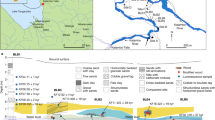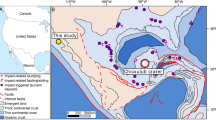Abstract
IN February 1955, a log about 10 ft. long and 5 ft. in girth was found washed up on a sandy beach just inside Port Davey harbour on Tasmania's south-west coast. It was lying between two logs of Huon Pine (Dacrydium franklinii Hook f.), an endemic conifer of Tasmania. Unlike these logs which were well covered with marine growth it was free from such growth although the surface was ‘woolly’ with many pebbles embedded in it. The ends of the log were sawn and one end grooved for towing by a wire rope. The wood was identified from its anatomy as a species of Nothofagus, which genus is represented in Tasmania, the south-eastern portion of the Australian mainland, New Zealand, New Guinea, New Caledonia and South America1. Anatomically the genus can be divided into two easily distinguishable groups, the one covering the species of New Guinea and New Caledonia, and the other the remaining species2. The log in question was derived from the second of these two groups and, because of the presence of spiral thickenings in the vessel elements, its specific identity could be narrowed down to one of three possibilities, namely, N. moorei (F. Muell.) Krasser of northern New South Wales and south-eastern Queensland, N. pumilio (Poepp. and Endl.) Krasser and N. obliqua (Mirb.) Oerst. from South America. The spiral thickenings in N. moorei differ from those of the two South American species; those of the unknown resembled the thickenings observed in the South American species. Both N. pumilio and N. obliqua are restricted to South America, the former occurring from Tierra del Fuego north to latitude 36° S. on the western side of the Andes. N. pumilio, N. antarctica (Forst.) Oerst. and N. betuloides (Mirb.) Oerst. are logged commercially in the southernmost tip of the continent3. All the anatomical evidence thus pointed to a South American origin of the log in question although this conclusion met with some initial opposition.
This is a preview of subscription content, access via your institution
Access options
Subscribe to this journal
Receive 51 print issues and online access
$199.00 per year
only $3.90 per issue
Buy this article
- Purchase on Springer Link
- Instant access to full article PDF
Prices may be subject to local taxes which are calculated during checkout
Similar content being viewed by others
References
van Steenis, C. G. G. J., J. Arn. Arb., 34, 301 (1953).
Dadswell, H. E., and Ingle, H. D., Aust. J. Bot., 2 (2), 141 (1954).
Paddon, T. W., Rev. Bois, 8 (5); and in “Timber Progress”, edit. by Bruce, W. E. (Cleaver Hume Press, London).
Cockayne, L., “The Vegetation of New Zealand” (Engelmann, Leipzig, 1921).
Matthews, I. H., “The Sea Elephant” (Scientific Book Club, 1952).
A.N.A.R.E. (unpublished log books).
Heyerdahl, T., “American Indians in the Pacific” (Allen and Unwin, London, 1952).
Sverdrup, H. U., Johnson, M. W., and Fleming, R. H., “The Oceans” (Prentice-Hall, New York, 1949).
Darwin, C., “On the Origin of Species” (John Murray, London, 1875).
Author information
Authors and Affiliations
Rights and permissions
About this article
Cite this article
BARBER, H., DADSWELL, H. & INGLE, H. Transport of Driftwood from South America to Tasmania and Macquarie Island. Nature 184, 203–204 (1959). https://doi.org/10.1038/184203a0
Issue Date:
DOI: https://doi.org/10.1038/184203a0
This article is cited by
-
Missing link in the Southern Ocean: sampling the marine benthic fauna of remote Bouvet Island
Polar Biology (2006)
-
Drifting plastic and its consequences for sessile organism dispersal in the Atlantic Ocean
Marine Biology (2005)
-
Continental movements, “Wallace’s Line” and Indomalayan-Australasian dispersal of land plants: Some eclectic concepts
The Botanical Review (1972)
-
Long-distance Seed Dispersal to Macquarie Island
Nature (1965)
Comments
By submitting a comment you agree to abide by our Terms and Community Guidelines. If you find something abusive or that does not comply with our terms or guidelines please flag it as inappropriate.



